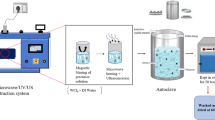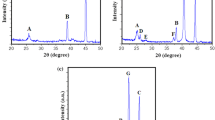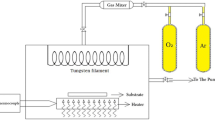Abstract
Tungsten oxide (W18O49) nanorods were grown by directly heating tungsten foils covered with potassium bromide (KBr) in low-pressure wet oxygen. The approach featured such advantages as convenient manipulation, low cost and rapid accessibility to high temperatures. A solid-liquid-solid (SLS) mechanism is believed to have dominated the growth process, in which the W18O49 nanorods segregated from eutectic droplets of potassium tungstate and tungsten oxide. The ultraviolet photoelectron spectroscopy (UPS) analysis disclosed that the valence band maximum (VBM) of these nanorods was approximately 9 eV below the vacuum level. The feasibility of using the such-fabricated nanorods as field emitters was tested and the related mechanism was also discussed.
Similar content being viewed by others
References
Kadam P M, Tarwal N L, Shinde P S, et al. From beads-to-wires-to-fibers of tungsten oxide: Electrochromic response. Appl Phys A, 2009, 97: 323–330
Zhao Z G, Miyauchi M. Nanoporous-walled tungsten oxide nanotubes as highly active visible-light-driven photocatalysts. Angew Chem Int Ed, 2008, 47: 7051–7055
Szilágyi I M, Saukko S, Mizsei J, et al. Gas sensing selectivity of hexagonal and monoclinic WO3 to H2S. Solid-State Sci, 2010, 12: 1857–1860
Zhu J, Wang S L, Xie S H, et al. Hexagonal single crystal growth of WO3 nanorods along a [110] axis with enhanced adsorption capacity. Chem Commun, 2011, 47: 4403–4405
Liu K, Foord D T, Scipioni L. Easy growth of undoped and doped tungsten oxide nanowires with high purity and orientation. Nanotech, 2005, 16: 10–14
Wang H, Xie Q, Zhang Y B, et al. Direct growth and photoelectrochemical properties of tungsten oxide nanobelt arrays. Nanotech, 2008, 19: 065704
Zhang W, Xi Z H, Zhang G M, et al. Carbon nanotube as the core of conical carbon fiber: Fabrication, characterization and field emission property. Appl Phys A, 2007, 86: 171–175
Liu J, Zhang G M, Qin J F, et al. Field emission from combined structures of carbon nanotubes and carbon nanofibers. Physica B, 2010, 405: 2551–2555
Woo K, Hong J, Ahn J, et al. Coordinatively induced length control and photoluminescence of W18O49 nanorods. Inorg Chem, 2005, 44: 7171–7174
Frey G L, Rothschild A, Sloan J, et al. Investigations of nonstoichiometric tungsten oxide nanoparticles. J Solid State Chem, 2001, 162: 300–314
Azimirad R, Goudarzi M, Akhavan O, et al. Growth and characterization of sodium-tungsten oxide nanobelts with U-shape cross section. J Cryst Growth, 2008, 310: 824–828
Qi H, Wang C Y, Liu J, et al. A simple method for the synthesis of highly oriented potassium-doped tungsten-oxide nanowires. Adv Mater, 2003, 15: 411–414
Gelsing R J H, Stein H N, Stevels J M, et al. The phase diagram K2WO4-WO3. Recueil, 1965, 84: 1452–1458
Ertl G, Küppers J. Low Energy Electrons and Surface Chemistry. VCH, Weinheim, 1985. 101
Park Y, Choong V, Gao Y, et al. Work function of indium tin oxide transparent conductor measured by photoelectron spectroscopy. Appl Phys Lett, 1996, 68: 2699–2701
Beerbom M M, Lägel B, Cascio A J, et al. Direct comparison of photoemission spectroscopy and in situ Kelvin probe work function measurements on indium tin oxide films. J Electron Spectrosc Relat Phenom, 2006, 152: 12–17
Hong K Q, Xie M H, Hu R, et al. Synthesizing tungsten oxide nanowires by a thermal evaporation method. Appl Phys Lett, 2007, 90: 173121
Wang S L, He Y H, Zouc J, et al. Synthesis of tungsten oxide tapered needles with nanotips. J Cryst Growth, 2007, 303: 574–579
Hsieh Y T, Chen U S, Hsueh S H, et al. Rapid formation of tungsten oxide nanobundles with controllable morphology. Appl Surf Sci, 2011, 257: 3504–3509
Wang S L, He Y H, Fang X S, et al. Structure and field-emission properties of sub-micrometer-sized tungsten-whisker arrays fabricated by vapor deposition. Adv Mater, 2009, 21: 2387–2392
Wagner R S, Ellis W C. Vapor-liquid-solid mechanism of single crystal growth. Appl Phys Lett, 1964, 4: 89–90
Merkulov V I, Lowndes D H, Wei Y Y, et al. Patterned growth of individual and multiple vertically aligned carbon nanofibers. Appl Phys Lett, 2000, 76: 3555–3557
Azimirad R, Akhavan O, Moshfegh A Z. Simple method to synthesize NaxWO3 nanorods and nanobelts. J Phys Chem C, 2009, 113: 13098–13102
Hong K Q, Yiu W C, Wu H S, et al. A simple method for growing high quantity tungsten-oxide nanoribbons under moist conditions. Nanotech, 2005, 16: 1608–1611
Wang S L, He Y H, Liu X L, et al. Large-scale synthesis of tungsten single-crystal microtubes via vapor-deposition process. J Cryst Growth, 2011, 316: 137–144
Zhang J L, Xi Z H, Wu Y, et al. Growth of micron-sized tubes of tungsten oxide. Colloids Surf A: Physicochem Eng Aspects, 2008, 313–314: 670–673
Lassner E, Schubert W D. Tungsten: Properties, Chemistry, Technology of the Element, Alloys, and Chemical Compounds. New York: Kluwer Academic/Plenum Publishers, 1999. 87
Bonard J M, Maier F, Stöckli T, et al. Field emission properties of multiwalled carbon nanotubes. Ultramicroscopy, 1998, 73: 7–15
Lee C J, Lee T J, Lyu S C, et al. Field emission from well-aligned zinc oxide nanowires grown at low temperature. Appl Phys Lett, 2002, 81: 3648–3650
Author information
Authors and Affiliations
Corresponding author
Rights and permissions
About this article
Cite this article
Qin, J., Zhang, G. & Xing, Y. Direct growth of tungsten oxide nanorods from heated tungsten foils. Sci. China Technol. Sci. 55, 1503–1508 (2012). https://doi.org/10.1007/s11431-012-4804-y
Received:
Accepted:
Published:
Issue Date:
DOI: https://doi.org/10.1007/s11431-012-4804-y




